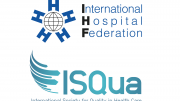Building mature, fully integrated digital ecosystems, with cutting-edge technologies at their centre, will lay the foundations for world-leading and efficient care that makes a real difference for patients, writes Hani Abouhalka, Company Group Chairman, Johnson & Johnson Medical Devices Companies, EMEA.
The COVID-19 pandemic will leave many legacies for the healthcare industry. Many are obvious, such as the increased prominence of health in the public mindset, or the close co-operation between healthcare systems, industry, academia, and Governments to deliver game-changing solutions when needed, most obviously with the vaccine development and roll out.
A more surprising legacy, however, is the rapid acceleration in uptake of digital technologies in healthcare. For example, right now, we know close to 50% of physicians and diagnostic specialists are using telehealth to treat patients, compared to just 18% pre COVID. To me, this demonstrates that healthcare systems have the ingenuity and drive to innovate and utilise digital technologies – and that industry has the ability and willingness to meet these needs.
The trends underlying this shift were already there. Think of value-based healthcare, which links cost efficiency to patient outcomes and particularly a need for data to measure and confirm value. Or the increase in available digital solutions supporting everything from patient pathways and surgical excellence to hospital logistics and virtual offices, delivered not just by traditional MedTech companies like my own but also innovative start-ups. Or the data science which captures the evidence from these same solutions. Or the telemedicine and omnichannel engagement which facilitates patient treatment and surgical support at a distance.
What’s clear however is that COVID-19 has been a catalyst for the accelerated use of such technology. Now, as we tentatively emerge from the pandemic, thanks in a large part to successful vaccination programmes, the question remains: with ever increasing elective surgery backlogs, how can we maintain this momentum with digital technologies and future-proof our healthcare systems to deliver the triple aim of improving outcomes, lowering cost, and increasing access? The answer, I believe, lies in building integrated ecosystems that connect the care pathway: pre-operative, in the OR, and post-operative care.
We know the vital benefits that technology can bring, particularly in limiting variation whilst improving patient outcomes. But too often we can focus on the individual pieces of technology, for example, the cutting-edge robots used in surgery. These are of course amazing innovations, but digital therapeutics is not just about individual solutions and technologies, no matter how eye-catching and exciting they might be. It is also about the vital framework around these solutions with policies for data, data ownership, and data privacy. By looking at the whole pathway and ensuring as much connectivity as possible, healthcare systems can lay the groundwork to capitalise on the full benefits that digital technology has to offer.
We need to imagine an integrated digital ecosystem that can connect all digital products and services. This will mean that anonymised data can be analysed, shared, and used to enhance existing solutions, and develop new modules that meet existing and future trends. Such a system also benefits patients by making the care pathway smoother, simpler and less stressful. It would reduce delays, allow patients to access care quickly and easily through remote connectivity, remove hospital system pain points, and improve efficiency.
At Johnson & Johnson, we are reimagining the future of health today by working to make such an ecosystem a reality. Our combined pharmaceutical, consumer health and medical technology expertise, alongside our global footprint, uniquely positions us to innovate next generation digital solutions.
We are developing a connected ecosystem of digital products and solutions that reimagines the entire patient journey – building integrated digital ecosystems that will connect all digital products and services, leveraging data science capabilities to generate deep insights powered by predictive analytics, machine learning and artificial intelligence.
We envision that this digital ecosystem can be embedded and accessed within existing hospital IT infrastructure so customers can focus on improving patient pathways, digital surgery and OR management. They will be able to gain insights and download apps and modules within different healthcare settings to manage the complete end-to-end patient pathway. Such an interconnected digital platform will allow us to continue developing next generation robotics, best-in-class surgical instruments, advanced visualisation and imaging tools, and digital solutions with AI and machine learning capabilities to drive the industry forward.
But industry cannot do this alone, and we need strong partnerships with healthcare systems, just like the ones forged during the midst of the pandemic, to implement and embed these digital ecosystems. The benefits of such a partnership for healthcare systems are clear: delivering improved patient experience through faster diagnosis, better pre-operative planning, more precise surgery, and better post-operative care; more insights and learnings for physicians who can also treat more patients (even remotely in overseas settings); overall greater efficiency in hospital and clinical settings; and reduced costs. The foundations for this within healthcare systems are already there too. 70% of European HCPs consider themselves digital natives and we’ve seen through the pandemic how quickly healthcare systems can adopt innovation.
I believe the time is now, when the world is finally able to start thinking about life after COVID, that industry and healthcare systems must capitalise on existing expertise and momentum. It is only by working together that we can build the mature digital ecosystems of the future – the kind of ecosystems that we need to fully embrace the revolution in medical technologies, and to ensure we deliver world-leading and efficient care.





